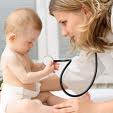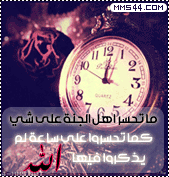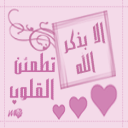نورس
*********




المشاركات : 30951
العمـر : 94
تعاليق : مؤسس منتدى النورس
المزاج : 
الدولة : 
المهنة : 
الهواية : 
التسجيل : 09/10/2008
النقاط : 39243
التقييم : 1559

 
 |  موضوع: Paediatric Examination موضوع: Paediatric Examination  الثلاثاء ديسمبر 14, 2010 6:57 pm الثلاثاء ديسمبر 14, 2010 6:57 pm | |
|
General points
It is important to have established rapport with parents and child when taking the history.
The approach to the examination will be determined by the age, level of development and level of understanding of the child.
Inspection and observation are the most important parts of the examination. Observations can be made whilst taking the history and establishing rapport. For example:
Observe the child's behaviour and level of awareness and take these into account with the parents own reports.
Consider if the childs appearance is unusual at all and in what way.
Note the shape of the head, mould of ears, position of eyes, body proportions, posture.
Does the child look like their parents?
Are there any recognisable major or minor anomalies?
Record the nature and distribution of skin lesions and rashes.
Note the colouring, shape and positions of bruises. If they have suspicious appearance, consider the possibility of non-accidental injury.
Avoid waking sleeping children.
Approach the child at their level, if necessary kneel on the floor. It may be impossible to examine pyrexial, irritable children without provoking crying and they should be carefully observed before attempting closer examination.
Start examining peripherally with hands and feet as this is less threatening.
Make the examination fun to help with their anxiety.
Make sure the child is comfortable, and that your hands, stethoscope and other instruments are warm.
Ask parents to assist with dressing or undressing children and be aware of sensitivities about this.
Wherever possible avoid unpleasant procedures (for example, rectal examination). These are seldom necessary and can put children off being examined for a lifetime.
Growth and pubertal development
There are some general points to consider:
Myelination of the nervous system at birth is incomplete.
Pubertal development has important implications for growth. Assessment of puberty is important when assessing growth.
Examination of children should incorporate accurate assessment of growth and pubertal development.
There are three phases of growth:
Infant phase:
Rapid first year and slowing in the second year of life.
Good nutrition is important for normal growth.
Metabolic hormones control growth.
Childhood phase:
From second to tenth year.
Pituitary hormones and growth hormone are important factors.
Pubertal or adolescent phase:
From onset of puberty until adult stature reached.
Sex hormones are the important factors.
Measurement
A variety of measurements can be recorded and plotted to allow accurate assessment of growth and pubertal development.
Head circumference routinely in under age 2 years.
Length or height in older children.
Weight.
Plotting of serial measurements to establish pattern and range of growth.
Use appropriate growth charts.
Skin fold thickness where indicated.
Assess and plot pubertal development where indicated.
Developmental assessment
An awareness of normal developmental milestones should be acquired by all doctors working with children.
Detailed assessment of development is complicated but useful assessments in the course of routine examinations and consultations can be achieved with experience and practice.
There are large variations in normal development.
Schemes to assess development centre on:
Motor skills: gross motor and fine motor.
Special senses: vision and hearing.
Communication: comprehension and expressive language.
Psychosocial aspects: social skills and behaviour.
Examination by system
The emphasis of the examination will vary depending on various factors (indications, age of the child, etc.). Some important components of paediatric examination in the main systems are listed.
The cardiovascular system
It may be a good idea to start the examination here, if the child is quiet and settled. Letting the child remain seated/held on the parent's or carer's lap, will reassure them:
Begin by recording pulse rate, rhythm, strength and character.
Palpate and percuss the anterior chest wall for heart size and the site and nature of the apex beat.
Also determine the presence of any thrill.
Listen to the 1st heart sound, then the 2nd heart sound, then the sounds between these and then any murmurs between heart sounds.
Note the timing, character, loudness, site and distribution of any murmur.
Check if this is transmitted to the neck.
If disease of the heart or kidney is suspected, record BP.
The respiratory system
Note respiratory rate and movement of the diaphragm and chest wall with quiet breathing and with stronger respiratory effort (requested from an older child or with crying in a baby).
Percuss the upper edge of the liver to determine if the lung is overinflated.
Breath sounds and additional noises can be difficult to interpret in the very young.
Noises vary from fine high-pitched to low and coarse depending on the site and nature of the obstruction and the narrowness of the aperture.
Crepitations (fine crackling noises on inspiration) can occur in apparently normal babies on careful auscultation. Persistent and bilateral crepitations in a distressed toddler usually suggest bronchiolitis or, rarely, left heart failure.
Rales (intermittent noises during inspiration and expiration) normally indicates liquid debris in larger airways and may be transmitted from the back of the throat.
Rhonchi (more persistent harsh noises added on to breath sounds) are less common in children and suggest a more persistent obstruction.
Bronchial breathing (continuous noises that harden and extend the breath sounds) heard over the baby's upper back are usually transmitted from the main airway.
Stridor (a harder and more vibrant noise) indicates that the airway is partially obstructed.
Wheezing occurs when the mid-airways are narrowed and needs to be checked if bilateral.
The gastrointestinal system
First observe the abdomen, looking for swellings and movements.
Enquire if there is any tenderness and if possible watch the childs face while you palpate the abdomen. If tenderness is present, and the child is systemically unwell, before palpating, ask the child to puff up their stomach, ('like a balloon'). This may elicit rebound, without touching and unintentionally hurting the child.
Palpate the 4 quadrants to determine systematically the position and size of the liver, spleen, kidneys and bladder.
Note the position, size, surface and texture of any enlarged organ, the character of the edge if it has one and whether or not it is tender.
Consider whether digital rectal examination is appropriate and explain to the parent. This examination is often neglected, when useful information can be obtained, e.g. with a history of constipation.1
The musculoskeletal system
Observe any abnormal curvature or deformities of the spine, particularly at the lower end.
In small babies, pay particular attention to the sacrum and observe any sinus or hairy naevi.
Be aware of normal variations ('in-toeing', femoral anteversion, genu valgus, genu varus, etc.).
Specific checks of hips and feet (see below).
The central nervous system
During the consultation consider whether the child has normal development in motor functions, speech and language and social interaction. Has the parent stated any specific concerns?
Always examine the anterior fontanelle by palpation in babies and infants. Note any pulsation and if it is normal.
The fontanelle should close by the middle of the 2nd year. It should be full or flat.
Note if the child can hear, see, move the eyes and head well in all directions, move all limbs and whether this movement is normal and full.
Note whether contour and position of each limb is normal with good power. Handle the child and note the tone of movement of the limb and whether there is any limitation to this.
Note if the joints are unduly lax and hyperextendable. Watch the child's face while you move the limbs.2
Although rarely useful, you may be able to elicit reflexes with the percussing finger instead of a hammer.
Examination at different ages
Examination will be outlined in different age groups. These are not intended to be exhaustive checklists but aim to highlight important aspects of the examination in these selected age groups, particularly where there are notable differences to adult examination. The emphasis and detail of any examination will be determined by the particular aims and purposes of the examination outlined above.
Newborn babies (see also separate article Newborn Screening).
Six week-old babies (see also separate article Six-week Review (CHS)).
7 to 9 month-old babies.
Toddlers or children under 2 years.
Pre-school children (see also separate article Pre-school Check (CHS)).
School-age children.
Adolescents (see also separate article Puberty: Normal and Abnormal).
Normal values
A distinctive feature of paediatric examination is that normal parameters change with growth and development. This is illustrated by the example of pulse, blood pressure and respiratory rate in different age groups in the table below.
Newborn babies
The assessment and examination of the newborn and neonates (under 4 weeks) often requires a specific and detailed series of checks, observations and measurements supplemented with detailed history from the parents. Babies are routinely checked and examined at birth and at between 6 and 8 weeks. This is covered in the separate article.
Six week-old babies
This is covered in the Six-week Review (CHS) article.
Important aspects of the examination:
Ill babies can be assessed according to the baby check system.3
The examination is similar to that for newborn babies.
Progress with feeding should be discussed.
Growth:
Weight, length and head circumference should be plotted.
Deviation from centiles should be discussed and followed up.
Development:
Milestones should be briefly reviewed in all babies.
General examination:
The parameters and methods are as for those outlined in young and newborn babies .
Hips may be examined again.
7 to 9 month-old babies
Important aspects of the examination:
This age group is frequently seen by doctors.
From the age of about 3 months viral illnesses are very common.
It is a period of rapid growth and development.
Routine checks are not now normally performed in this age group.
Assessment of growth and development is usually done opportunistically.
Growth:
Growth is very rapid (with a doubling on average of birthweight by 5 months).
Length and weight should be plotted and compared with previous readings.
It can be very difficult to obtain an accurate length in this age group.
Development:
Parents will often present with children when there are concerns over developmental progress.
It is a period of rapid developmental progress.
Developmental milestones should be reviewed opportunistically. For example:
Social smile should have appeared by 8 weeks.
Children should be sitting unsupported by 8 months.
Children should be babbling by 8 months.
General examination:
Rashes are common with frequent viral infections particularly.
Doctors should be familiar with important rashes (such as the purpuric rashes of meningococcal septicaemia, idiopathic thrombocytopenic purpura and Henoch- Schönlein purpura).
Cardiovascular examination:
Cardiac output is regulated mostly by changes in heart rate (as with newborn and younger babies). Tachycardia is an important sign which needs explanation.
Respiratory examination:
This is frequently performed in this age group.
Observation is again very important.
It is important to distinguish wheeze from stridor.
Gastrointestinal examination:
Observation is again important. For example, with peritonitis. The child lies very still with flexed knees and shallow breaths.
Inspect anogenital area if appropriate. This is an increasingly difficult examination as children get older and requires sensitive handling.
Warm hands and reassurance are needed to palpate the abdomen of an ill child.
Neurological and developmental examination:
Formal examination is very difficult. Improvisation is often required.
Cranial nerves are examined by observation - for example, of behavioural and facial movements. Cranial nerve abnormalities in this age group include:
Bell's palsy
Eighth cranial nerve impairment (sensorineural deafness)
Sixth cranial nerve deficit (convergent squint) with raised intracranial pressure
Toddlers
Important aspects of the examination:
Toddlers are infants who are walking (usually over 1 year) but under 2 years of age.
Again this group consults often.
Attendance is likely to be distributed between different settings (for example, hospital, primary care, clinics, walk-in centres).
It is important for there to be good communication between these different agencies.
Growth and development is rapid.
Checks of growth and development will often have to be done opportunistically.
Genu varus is physiological in this age group.
Growth:
Growth decelerates from the end of the first year.
Head growth is rapid as the brain grows with myelination in cortical areas.
Development:
Important milestones should be identified. Briefly:
Hand dexterity improves along with visual acuity from palmar grasp to pincer grip in the first year. By the second year a tower of 6 bricks can be achieved
Speech develops from babbling to 6 or more words at 18 months and short phrases during the second year
Comprehension allows simple instructions to be followed by about a year
Babies progress from crawling to cruising and then walking by about a year (before 18 months)
General examination:
It is usually best to examine babies on the parent's lap and establish relaxed rapport.
Engage in play to facilitate the examination.
It may be necessary to be quite selective and examine important or relevant systems first.
Leave more intrusive or unpleasant examinations until the end (for example, throat examination).
Cardiovascular examination:
Refer to normal values.
Identify innocent murmurs (often heard).
Respiratory examination:
Observe and identify normal rate, breathing sounds and pattern.
Gastrointestinal examination as above.
Neurological and developmental examination as above.
Pre-school children (age 2 to 5 years)
Important aspects of the examination:
This age group also frequently attends for medical care and advice.
Illness and, increasingly, accidents will prompt attendance.
Again, rapport and confidence have to be established and maintained for easier examination. Trust can be built for future examinations.
Genu valgus is physiological in this age group.
Growth:
Growth is decelerating at this stage.
Centile charts should be used and checked.
Development:
The most marked advances are in communication skills and use of language.
An assessment of language skills should be briefly made in all children.
General examination:
Again, most often achieved on a parent's lap or standing close to the parent.
Explain and commentate on procedures as they progress. Answer questions - they are usually very inquisitive at this age.
Cardiovascular examination:
Examination is easier in this age group.
Again, innocent murmurs are common.
Heart sounds are more easily identified with slower heart rates.
Respiratory examination:
Observation is again most important.
Peak flow measurement is not reliable until about age 5 years (see separate article Diagnosing Childhood Asthma in Primary Care).
Gastrointestinal examination:
It is often best to examine kneeling down alongside the patient.
Children may prefer palpation to be done with their hand underneath the examiner's.
Hip and knee examination:
Irritable hip and other hip conditions can occur at this age and require assessment.
Normal genu varus (physiological in the toddler) and valgus (physiological in the pre-school child) often require reassurance at this age.
Neurological and developmental examination:
This increasingly approaches what is possible in adults.
Vision can be checked by shape or letter matching at 3 years of age.
A circle will be copied by 3 years, a cross by 4 years, a square by 4.5 years and triangles by about 5 years.
School-age children (from 5 to 10 plus years)
Important aspects of the examination:
This age group is examined less often by doctors.
Psychological factors begin to play more of a part in how problems present.
Growth:
Growth will be steady leading up to the pubertal growth spurt.
Concerns may begin to be expressed about growth and development in relation to puberty.
Development:
Social and behavioural aspects of development become more important.
Other aspects of development approach those of adults.
Examination:
There are now few differences from adult examination.
Adolescents (from the onset of puberty)
Important aspects of the examination:
Adolescents attend for medical advice infrequently.
Rapport and good communication may be difficult to establish.
Psychological factors are likely to be very important.
Most adolescents are very self-conscious and this can impede adequate examination.
It is recommended to have a chaperone.
Confidentiality and consent become more important issues.
Growth:
Puberty initiates a period of rapid growth.
Normal and abnormal puberty should be recognised.
Examination:
Examination is very similar to that undertaken in adults.
| |
|
الجوهرة المصونة
*****




المشاركات : 17164
العمـر : 36
تعاليق : مشرفة الطب والصحة
المزاج : 
الدولة : 
المهنة : 
الهواية : 
التسجيل : 10/10/2008
النقاط : 18248
التقييم : 501

 
توفيقك يارب

 |  موضوع: رد: Paediatric Examination موضوع: رد: Paediatric Examination  الجمعة ديسمبر 17, 2010 6:37 pm الجمعة ديسمبر 17, 2010 6:37 pm | |
| thank u so much on this topic | |
|
عاشقة الزهور
*****




المشاركات : 75737
العمـر : 41
المزاج : 
الدولة : 
المهنة : 
الهواية : 
التسجيل : 09/03/2009
النقاط : 101796
التقييم : 846
 |  موضوع: رد: Paediatric Examination موضوع: رد: Paediatric Examination  الخميس ديسمبر 23, 2010 3:24 pm الخميس ديسمبر 23, 2010 3:24 pm | |
| | |
|





